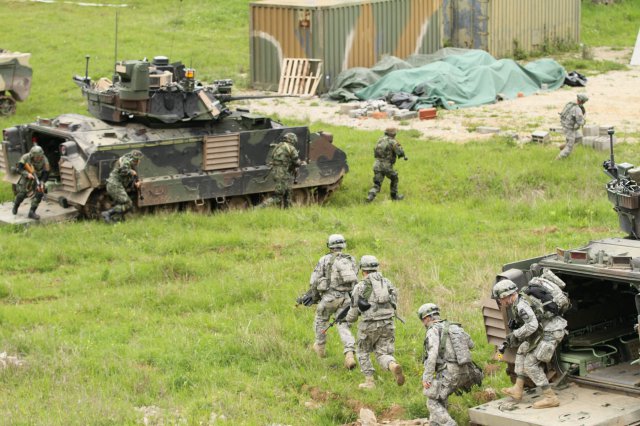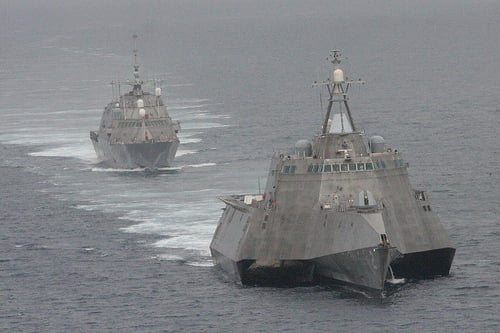
Army troops dismount their M2 Bradleys in a simulated assault.
As the Pentagon finishes its strategic review, the stage is set for another struggle over whether to ready for a high-end war with Russia or China or just manage the current, much lower intensity battles around the world.
In military terms it’s a choice between capability and capacity. The outcome will shape the four services modernization portfolios, the size of America’s military, and how ready our forces are to fight.
Strategists focus on the high-end conflicts and Defense Secretary Jim Mattis seems so inclined once immediate readiness shortfalls are fixed. But he is likely to find what his predecessors did, that the press of today’s conflicts and crises pushes the department to expand forces and build readiness. CSIS has analyzed the administration’s fiscal 2018 budget and we found that the services were leaning towards force structure and readiness — capacity — despite the pressing strategic imperative for modernization (capability). The result of this tension is likely to be a high-low mix that tries to cover both.
High-End Conflict
It is a commonplace observation that great power competition has returned after a generation. China and Russia are challenging the global order and have the ability to set up very sophisticated anti-access/area denial environments. Strategists naturally focus on this challenge because it is the most demanding and the basic military planning approach to is to assume the worst and plan for it. Only Russia and China can compete with the United States in all five warfighting domains — ground, sea, air, space, cyber. So-called peer conflicts put far different demands on the forces than the regional conflicts and stability operations that the United States has conducted for the last 25 years. Competing requires developing and fielding the most advanced technologies and implementing new war fighting doctrines to go with these technologies, for example, distributed operations to avoid vulnerable concentrations, and long-range precision strike to stay outside of the adversary’s defensive bubble.

Mark Cancian
Mattis seems to be focused on this. After rebuilding readiness in the fiscal 2017 and 2018 budgets, he has signaled that the next one will focus on Russia and China, “We cannot focus solely on urgent threats when other countries with far greater potential to threaten our future security continue to expand their military capability.” Gen. Joe Dunford, Chairman of the Joint Chiefs, noted the implications of that approach for force size: “I don’t see, in the near term, our ability to really grow the force.”
Day-to-day Superpower Commitments. Unfortunately, the world has not been cooperating with this vision. The 2014 Quadrennial Defense Review anticipated that force demands would decline once the US withdrew from Iraq and Afghanistan. That would allow forces and near-term readiness to be cut. However, this projection was immediately upset by Russian aggression in Crimea and the Ukraine, ISIS conquests in Syria and Iraq, and China’s increasing assertiveness in the South China Sea.
The United States responded by deploying more forces. For Europe, a long neglected theater, the U.S. created the European Reassurance Initiative (ERI), which stopped the withdrawal of U.S. troops from Europe, expanded engagement with allies in Eastern Europe and the Baltics and began the rebuilding of infrastructure to facilitate rapid reinforcement. Originally conceived as a one year program, ERI is in its fourth year and projected to continue indefinitely. Funding has increased from the original $1 billion to a proposed $4.3 billion in fiscal 2018. Troop commitments have increased commensurately, with an armored brigade now rotating continuously to Europe.
In the Middle East, the US began an air war against ISIS in both Iraq and Syria. Over time, it has also ramped up the ground component beginning with special forces teams and now including a wide variety of ground combat troops acting in support of local forces. In Afghanistan, the US halted its withdrawal. In the Pacific, the US has tried to “rebalance” by moving 60 percent of its naval strength to meet the rising challenge from the Chinese Navy. The Trump administration has continued these deployments, even expanding them with there recently announced “mini-surge” in Afghanistan.

LCS-2, USS Independence, followed by LCS-1, USS Freedom, showing the two different designs.
In the Obama administration, this strategic tension produced a clash between Defense Secretary Ash Carter and Navy Secretary Ray Mabus. Carter had established the Third Offset Strategy that sought to build advanced capabilities for conflict against a peer competitor. Mabus, feeling the stress on naval forces, wanted to increase the size of the Navy fleet. The competing visions came to a head over the LCS program. Mabus wanted to build 52; Carter directed that the program be cut to 40.
The Services
Today, these tensions have expanded to all the services. Each of the four services complains that it is too small to meet the day to day demands that have been put on them. As result, they have leaned towards capacity and readiness, and sacrificed modernization if they had to.
- The Army maintained the congressionally directed manpower level of 1,018,000 and did not decline to 980,000. Chief of Staff Gen. Mark Milley noted that: “We’ve done the analysis and we think we need to be bigger” and asked for 14,000 more soldiers in his unfunded requirements list. The Army did not have the money to propose any new modernization programs, although it desperately wants to start developing advanced ground combat and aviation systems.
- The Navy can meet only half of the regional commanders’ requests for Navy ships, although these are admittedly unconstrained requests. As a result, it has set a new target of 355 ships, up from the old target of 308. Like the Army, it decided to buy existing platforms in order to grow quickly, rather than take the time to develop new platforms. The Navy is even considering reactivating retired frigates.
- The Marine Corps maintains the congressionally increased endstrength of 185,000 and has set a target endstrength of 194,000.
- The Air Force noted “an insatiable demand for airpower” as it conducts an air war in the Middle East while still meeting all of its global commitments. As result, it maintains the A-10 fleet, which it had planned to retire, and is expanding its efforts to upgrade and extend the life of the legacy F 16C/D and F-15C fleets. To pay for this, it reduced F-35 procurement, requesting only 46 in 2018, down from the previous level of 48 and far below the target of 60 per year. It is even investigating procurement of light attack aircraft to provide a low-cost force expansion for low threat environments.
In the past, the services have resolved this tension by adopting what they call a high-low mix. They build some systems with advanced capabilities to deal with peer competitors while also building less capable systems to fill out their force. The classic example was the Navy in the 1980s, when it built Aegis cruisers (CG-47s) for a high-end fight with the Soviet Union and large numbers of Perry-class frigates (FFG-7s) for escort duties and forward presence.
Of course, a large defense buildup could do everything — build capacity and capability, with innovation, quality of life, compensation, and a lot of other things besides — and that’s what the services would like to do. Unfortunately, the fiscal future is highly uncertain. In fiscal 2022, there’s a $100 billion difference between the spending level prescribed by the Budget Control Act and that recommended by Sen. John McCain and Rep. Mac Thornberry. Further, the fiscal future is not all that favorable. The Trump Administration was not able to get its full defense increase in fiscal 2017 or make an agreement for the next year. Where the budget comes out will have a profound effect on the size of the forces and the service modernization programs. But that’s a topic for another time.
Mark Cancian a former senior official at the Office of Management and Budget, is a defense expert at the Center for Strategic and International Studies.
Connecticut lawmakers to grill Army, Lockheed about job cuts at Sikorsky helicopter unit
“The Connecticut delegation has questions about why, with that [FY24] appropriation in hand, this happened,” said Rep. Joe Courtney, D-Conn.


























